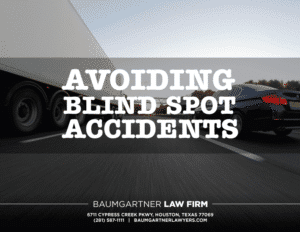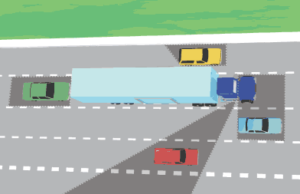
 Request FREE consultation - 1866-758-4529
Request FREE consultation - 1866-758-4529

What is the Blind Spot? A blind spot is a place in either lane adjacent to the one being driven in at an approximately 45-degree angle to the driver where neither the side view or rear-view mirror picks up the presence of another motor vehicle.
When changing lanes in either direction the driver is required to “head check,” i.e., take their eyes off of the road in front for a second or two and to look to see if a car is obstructing their turn. As the nation’s highway systems expand more lanes are added making them more dangerous to motorists wishing to change lanes. It is not uncommon for interstate highways to run five or more lanes in each direction.
Switching lanes to pass a slower vehicle or to get on the off-ramp lane puts the motorist in danger of colliding with another car that may be traveling in the driver’s blind spot. Nearly 1 million accidents occur each year due to a driver making a lane switch without first checking to see if another automobile is in their blind spot.
No driver is immune to the risk of blind spot accidents. Failing to check the blind spot before making a lane switch can cause serious, even fatal automobile accidents and none are more serious than those that involve an automobile and a commercial vehicle.
Most accidents involving 18-wheelers happen because the 18-wheeler has several large blind spots and the driver of a smaller motor vehicle operator unaware of the big rig’s unique safety requirements.

A tractor-trailer’s blind spot extends the entire right side of the trailer and there is no way for a commercial driver to head check to see if another vehicle is occupying that space.
A motorist to be aware of this and never travel or attempt to pass an 18-wheeler on the right, even in slow-moving traffic. Avoiding blind spot accidents there are several safety tips to help a driver minimize the chances of being involved in a blind spot accident.
Blind spots exist for all big trucks, including dump trucks, garbage trucks, tanker trucks and tractor-trailers.
First is to drive within the speed limit designed to maximize a driver’s ability to avoid potential collisions.
Second is to know that other drivers have blind spots also and minimize the time spent in them to only a brief second while passing. Also, do a physical head check to make sure that another driver traveling in the blind spot can be seen.
The blind spot can be eliminated for drivers of automobiles according to the University of Wisconsin on their motor vehicle science safety page http://pages.cs.wisc.edu/~gdguo/driving/BlindSpot.htm, the mirrors on all late-model motor vehicles can be adjusted as follows to eliminate the blind spot. “The first step is to adjust the rear-view mirror to do exactly that – give you a view directly to the rear. Position it so that it best covers your view straight out the rear window. Don’t bother tilting it to one side or the other to assist with your view of traffic to either side of your car. That’s what the side mirrors are for.
Next, lean your head until it almost touches the driver’s side window. Then, adjust your left side mirrors so you can just barely see the side of your car and no more than that.
Lean your head to the right towards the middle of the car and adjust the right-side mirror so you can just barely see the right side of your car. You should NOT be able to see the side of your car when your head is upright. Why would you want to? When was the last time your own car ran into itself?
Check for blind spots by doing: While driving along a four-lane road in the right lane, note a vehicle in the left lane coming up to pass you from behind.
Without moving your head, glance in the rear-view mirror and follow it as it approaches your car in the left lane. Just before it disappears from your view in the rear-view mirror, glance to the left side mirror. There it is.
Now, follow that vehicle in the side mirror as it passes you. Then, just before it disappears from the side mirror, see it with your peripheral vision. Notice that without even turning your head, you never had a blind spot. Then, try it with the right-side mirror. Watch as you pass a vehicle traveling in the right lane go from your peripheral vision to your right-side mirror, to your rear-view mirror.
Again, no blind spot. If there is a blind spot for even a fraction of a second, your side mirror adjustment needs fine-tuning.”
With all the advice given for adjusting the mirrors to pick up a motor vehicle in the blind spot, a quick head check is an additional assurance you may change lanes safely.
When driving on the roadway near a tractor-trailer, be aware of the areas around the big rig that are blind spots and try to avoid them for any length of time.
Houston truck accident lawyers have been helping injured victims since 1985.
Related Resources:
Blind spot accidents with 18 wheelers
Wide Right Turn Truck Accidents: A Comprehensive Guide
Avoiding an 18-Wheeler Accident in Houston
Lane Change Truck Accidents Lawyer
What Commercial Truck Drivers Know That You Don’t?